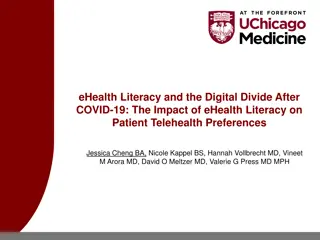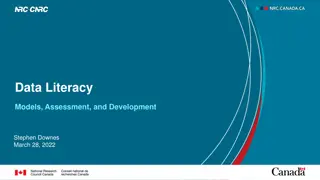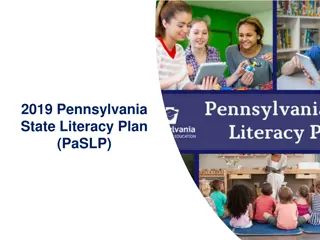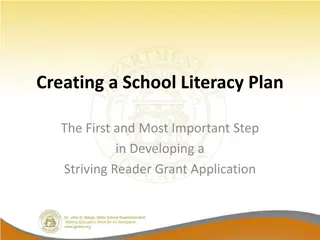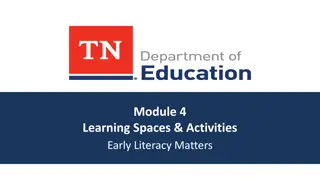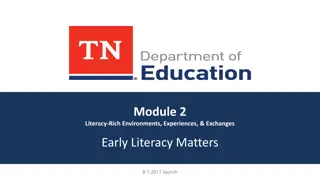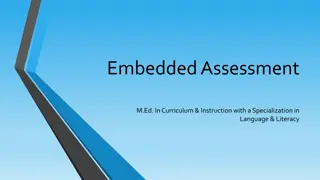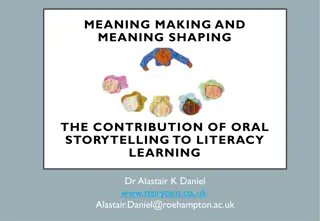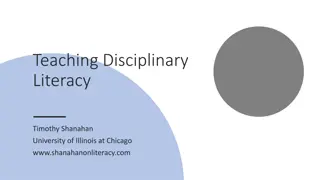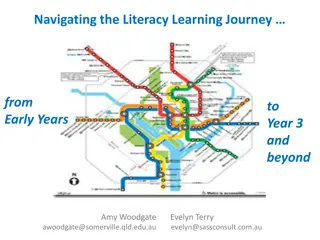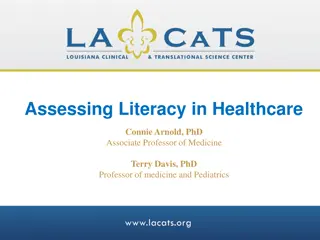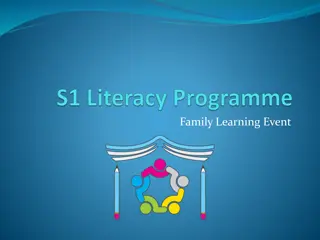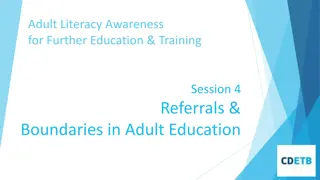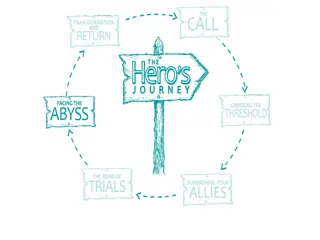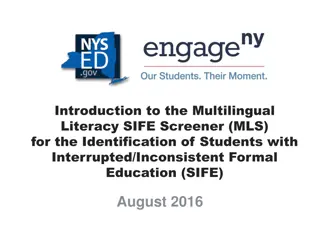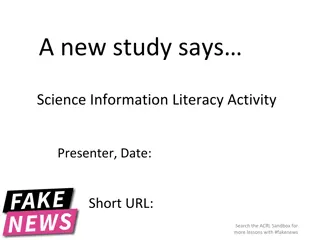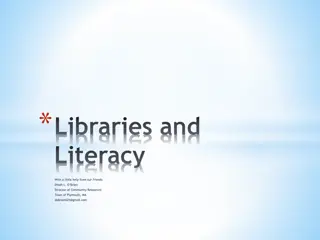Understanding the Characteristics of News and News Literacy
News plays a vital role in informing, shaping opinions, and influencing decision-making. This article explores the characteristics of news including objectivity, timeliness, relevance, proximity, and impact. Objectivity ensures unbiased reporting, timeliness focuses on recent events, relevance targets specific audiences, proximity considers geographic or cultural closeness, and impact evaluates the significance of news events.
Download Presentation

Please find below an Image/Link to download the presentation.
The content on the website is provided AS IS for your information and personal use only. It may not be sold, licensed, or shared on other websites without obtaining consent from the author. Download presentation by click this link. If you encounter any issues during the download, it is possible that the publisher has removed the file from their server.
E N D
Presentation Transcript
News Literacy DR. PAWAN KOUNDAL ASSOCIATE PROFESSOR, DEPARTMENT OF NEW MEDIA INDIAN INSTITUTE OF MASS COMMUNICATION, NEW DELHI AUGUST 21, 2024, 4.00 pm 1
What is News News refers to any current event, significant development, or issue of public interest. Normally reported through media outlets like newspapers, television, radio, internet sites, and social media. News performs the role of informing the public, shaping opinions, and sometimes influencing decision-making. 2
Characteristics of News Objectivity: refers to the practice of reporting news in a fair, balanced, and impartial manner, free from personal biases, opinions, or emotions. 3
Objectivity Builds trust with the audience by presenting unbiased, credible, and reliable news. A balanced report on a controversial policy with facts from all sides. Trust and Credibility Ensures all perspectives are fairly presented, giving voice to different sides of an issue. Covering a protest with interviews from both protesters and officials. Fair Representation Clearly distinguishes between factual reporting and opinion, helping audiences discern between the two. Reporting the facts of a legal case separately from editorial opinions. Separation of Fact and Opinion Strives to reduce personal or institutional biases by using neutral language and balanced coverage. Neutral reporting on political candidates without showing favoritism. Minimization of Bias 4
Characteristics of News Timeliness News is often centered around recent events or developments. The more current the information, the more likely it is to be considered newsworthy. Breaking news about a natural disaster or a political event. 5
Characteristics of News Relevance News must be relevant to the audience it is intended for. What is newsworthy in one community or country may not be in another. Local elections may be newsworthy in a small town but less so on a national level unless they have broader implications. 6
Characteristics of News Proximity Geographical or cultural proximity often determines the newsworthiness of a story. Events that happen closer to the audience are usually given more coverage. A significant local event might be more important to local readers than international news. 7
Characteristics of News Impact The potential impact or significance of an event can make it newsworthy. Stories that affect a large number of people or have a profound influence on the community tend to be prioritized. A major government policy change or a public health crisis. 8
Characteristics of News Prominence The involvement of prominent figures (celebrities, politicians, business leaders) can increase the newsworthiness of a story. A statement made by the President or a celebrity. 9
Characteristics of News Conflict News often highlights conflicts, controversies, or disagreements, as they tend to attract more attention. Political debates, legal battles, or social protests. 10
Characteristics of News Novelty Unusual, rare, or surprising events tend to be more newsworthy because they stand out from the ordinary. An unusual weather event or a scientific breakthrough. 11
Human Interest Stories that evoke emotions, whether they are heartwarming, tragic, or inspiring, are often considered newsworthy. An individual overcoming significant odds or a community coming together to help someone in need. 12
What is News Literacy? The ability to carefully examine news and information. It involves: Understanding how news is created. Finding reliable sources. Spotting bias/perspectives in news. Knowing the difference between facts and opinions. Being aware of false information and misinformation. 13
Importance of news literacy News literacy is increasingly important in the digital age, where information is abundant, and misinformation can spread rapidly. It is crucial to discern fact from fiction, identify biases, and understand the impact of news on society. 14
Distinguishing Between News and Opinion Recognizing when a piece is a news report and when it is an editorial or opinion piece, and understanding how this affects the content. Op-ed sections in newspapers like The Hindu or Times of India often feature opinion pieces that reflect the author s viewpoint rather than objective reporting. 15
Distinguishing Between News and Opinion Labeling and Section Placement Is the article labeled as "Opinion," "Editorial," "Analysis," or "Commentary"? Is the article located in a section typically reserved for opinions (e.g., Op-Ed, Editorial page)? Likely an opinion piece 16
Distinguishing Between News and Opinion Author s Perspective Does the author express personal viewpoints or subjective interpretations? Are phrases like I believe, In my opinion, or We should used? Use of Subjective Language Does the article use subjective or emotional language (e.g., terrible, outrageous, wonderful )? 17
Distinguishing Between News and Opinion Presentation of Facts Does the article primarily present verifiable facts and data without interpretation? Likely a news report. 18
Distinguishing Between News and Opinion Author s Identity and Expertise Is the author identified as a columnist, commentator, or expert with a specific viewpoint? Likely an opinion piece. Purpose of the Article Is the primary purpose of the article to inform and report facts? Likely a news report. 19
Distinguishing Between News and Opinion Headlines/copy Does the headline/copy use strong, opinionated language? Likely an opinion piece. Is the headline/copy neutral and focused on the "who, what, when, where, why, and how (5w1h)? Likely a news report. 20
Distinguishing Between News and Opinion Structure and Style Is the article structured with a clear beginning, middle, and end focused on a narrative or argument? Likely an opinion piece. Is the article written in a straightforward, objective style with a focus on delivering information? Likely a news report. 21
Evaluating Credibility of a News Story Take a recent news story and evaluate the credibility of the source by researching the publication s history, balance and the evidence cited in the story. 22
Evaluating Credibility of a News Story Credibility Aspect Publication History Criteria Is the publication reputable and established? Is the publication known for unbiased reporting? Are sources clearly identified and verifiable? Does the article include data, statistics, or direct quotes from credible sources? Are there hyperlinks or references to primary sources? Yes/No Evidence Cited Balance of Viewpoints Are multiple perspectives presented? Is the language neutral and objective? 23
Understanding News Sources Choose a news story and find how it's covered by at least three different types of sources: a mainstream newspaper, a digital-only news platform, and a social media post. Compare how each source presents the story 24
Understanding News Sources Mainstream Newspaper Digital-Only Platform Social Media Post Detailed article, neutral Multimedia elements, modern Short post, visual- heavy Presentation Conversational, engaging Informal, sensational Language Formal, factual Links to further reading, expert opinions Depth of Coverage In-depth analysis, context Brief, surface-level 25
Understanding Clickbait Clickbait is used primarily to drive traffic to a website or platform by enticing users with exaggerated or deceptive headlines. The goal is often to generate ad revenue, increase page views, or boost engagement metrics, even if the content fails to provide meaningful or accurate information. 26
Tactic Description How to Spot Look for phrases like "You won't believe," "Shocking secret," or anything that seems too sensational. If the headline doesn't clearly explain the content, it's likely clickbait. Headlines use sensational or exaggerated language. Exaggerated or Sensational Headlines Headlines provide vague information, forcing you to click for more details. Vague or Incomplete Information Uses extreme language like "best," "worst," "unbelievable." If the headline is full of superlatives or extreme statements, it's probably clickbait. Overuse of Superlatives Be skeptical of headlines promising insider knowledge or something "the media won't tell you." Check if the image seems unrelated to the content or overly dramatic. Verify the credibility of the website or publication before clicking. If the page is filled with ads and pop-ups, the content is likely clickbait. Claims to reveal "secret" or "exclusive" information. Promises of Secret Information Uses dramatic or unrelated images to grab attention. Often comes from lesser-known, unreliable websites. Clickbait sites are often cluttered with ads and pop-ups. Misleading Images/Thumbnails Unreliable Source Too Many Ads and Pop-Ups Content often underdelivers compared to the headline. Compare the headline to the actual content; if it doesn't deliver, it's clickbait. Content Doesn t Match Headline 27
Identifying Bias or Perspective in News Coverage Select a recent or ongoing issue that has been widely covered in the Indian media. It could be a social issue, a major event, or a public figure's actions. Identify and list the words or phrases that indicate a particular bias or perspective. Coverage of the air pollution crisis in Delhi during winter. 28
Identify Two News Outlets with Distinct Perspectives Headlines and Subheadings: Note how each outlet frames the issue from the headline. Language and Tone: Focus on the choice of words and the tone used to describe the situation. Sources and Attribution: Observe which sources are cited, such as government officials, health experts, or local residents. 29
Identify Words and Phrases Sensational or Calming Language: Are there words like emergency, toxic, or severe versus under control or improving ? Framing of Responsibility: How are the government, industries, or citizens described? Are they portrayed as neglectful, proactive, or victims ? Selective Focus: Does one outlet focus more on government action (or inaction) while the other emphasizes the public health impact? Tone of Headlines: Do the headlines make the crisis seem urgent and alarming, or do they downplay the severity? 30
News Outlet 1 (Policy Focused) Aspect News Outlet 1 (Environment Focused) "Delhi Chokes: Severe Air Pollution Threatens Public Health" "Government Steps Up Efforts to Combat Delhi Air Pollution" Headline Language "Toxic air" "Measures in place" Framing of Responsibility "Neglectful policies" "Government taking action" Selective Focus Focused on health impact and expert warningsFocused on government response and policy measures Tone of Headlines Urgent, alarming Controlled, solutions-oriented 31
Challenges for news/information literacy in the digital age. Information overload Misinformation and Disinformation Echo Chambers and Filter Bubbles Decline in Traditional News Outlets The Speed of News Dissemination Lack of Media Literacy Education Visual and Video Misinformation 32
Challenge Description Vast amounts of information online overwhelm people, making it hard to distinguish reliable sources. False information spreads easily, both intentionally and unintentionally. Social media curates content that aligns with users' beliefs, limiting exposure to different viewpoints. Impact Leads to quick skimming instead of careful evaluation of content. Information Overload Increases belief in false information, especially when shared by trusted contacts. Reinforces existing biases, reducing critical thinking and exposure to diverse perspectives. Misinformation and Disinformation Echo Chambers and Filter Bubbles 33
Financial struggles and the rise of digital media lead to less investigative reporting and more sensationalism. Reduces in-depth, accurate reporting, undermining journalism's role in public service. Results in the widespread sharing of incorrect information. Makes it harder to navigate modern media complexities and discern reliable sources. Increases trust in falsified content, making misinformation harder to detect. Decline in Traditional News Outlets Speed of News Dissemination News spreads rapidly online, often before being verified. Many people lack education on how to critically analyze news. The rise of deepfakes and visual manipulation makes it hard to distinguish real from fake content. Lack of Media Literacy Education Visual and Video Misinformation 34
Thank you. 35




